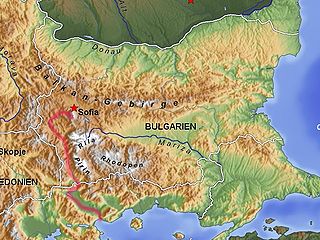
Amyntas I was king of the ancient Greek kingdom of Macedonia from at least 512/511 until his death in 498/497 BC. Although there were a number of rulers before him, Amyntas is the first king of Macedonia for which we have any reliable historical information. During Amyntas' reign, Macedonia became a vassal state of the Achaemenid Empire in 510 BC.

Serres is a city in Macedonia, Greece, capital of the Serres regional unit and second largest city in the region of Central Macedonia, after Thessaloniki.
The Bithyni were a Thracian tribe who lived in Bithynia.

The Struma or Strymónas is a river in Bulgaria and Greece. Its ancient name was Strymṓn. Its drainage area is 17,330 km2 (6,690 sq mi), of which 8,670 km2 (3,350 sq mi) in Bulgaria, 6,295 km2 (2,431 sq mi) in Greece and the remaining 2,365 km2 (913 sq mi) in North Macedonia and Serbia. It takes its source from the Vitosha Mountain in Bulgaria, runs first westward, then southward, forming a number of gorges, enters Greece near the village of Promachonas in eastern Macedonia. In Greece it is the main waterway feeding and exiting from Lake Kerkini, a significant centre for migratory wildfowl. Also in Greece, the river entirely flows in the Serres regional unit into the Strymonian Gulf in Aegean Sea, near Amphipolis. The river's length is 415 kilometres (of which 290 kilometres in Bulgaria, making it the country's fifth-longest and one of the longest rivers that run solely in the interior of the Balkans.

In antiquity, Paeonia or Paionia was the land and kingdom of the Paeonians or Paionians.

The Agrianes or Agrianians, were a tribe whose country was centered at Upper Strymon, in present-day central Western Bulgaria as well as southeasternmost Serbia, at the time situated north of the Dentheletae. Per Strabo the source of the river Strymon was within Agrianes' territory. In the times of Philip II of Macedon, the territory of the Agrianes was administered by Pella. They were crack javelin throwers and an elite unit of Alexander the Great's light infantry, who fought under the command of General Attalus.

The Pieres were a Thracian tribe connected with the Brygi, that long before the archaic period in Greece occupied the narrow strip of plain land, or low hill, between the mouths of the Peneius and the Haliacmon rivers, at the foot of the great woody steeps of Mount Olympus. This region was named after them as Pieria.

Eion, ancient Chrysopolis, was an ancient Greek Eretrian colony in Thracian Macedonia specifically in the region of Edonis. It sat at the mouth of the Strymon River which flows into the Aegean from the interior of Thrace. It is referred to in Thucydides' History of the Peloponnesian War as a place of considerable strategic importance to the Athenians during the Peloponnesian War.

Skudra was a province (satrapy) of the Persian Achaemenid Empire in Europe between 510s BC and 479 BC. Its name is attested in Persian and Egyptian inscriptions (an Egyptian record of c. 498–497 BC, and a list on the tomb of Darius the Great at Naqsh-e Rustam, c. 486 BC. It is believed to have comprised the lands now known as Thrace and Macedon.

Odomanti or Odomantes were an ancient tribe. Some regard it as Paeonian, while others claim, that the tribe was with certainty Thracian. The Odomanti are noted by Herodotus, Thucydides, Stephanus of Byzantium and Pliny the Elder.

Paeoplae were an ancient Paeonian tribe in Thrace. The name is suggested to have Thracian origin.

Doberes were an ancient Paeonian tribe in Thrace.
Sirra or was an ancient Greek polis located in Thrace, in the region between the river Strymon and the river Nestos. The city ethnic name was or and its territory was called. Sirra was located in the territory of the Odomantes.

Achaemenid Macedonia refers to the period in which the ancient Greek Kingdom of Macedonia was under the reign of the Achaemenid Persians. In 512/511 BC, the Persian general Megabyzus forced the Macedonian king Amyntas I to make his kingdom a vassal of the Achaemenids. In 492 BC, following the Ionian Revolt, the Persian general Mardonius firmly re-tightened the Persian grip in the Balkans, making Macedon a fully subordinate kingdom within the Achaemenid domains and part of its administrative system. Macedonia served the Achaemenid Empire during the Greco-Persian Wars in their invasion of mainland Greece. They regained independence following the defeat and withdrawal of the Achaemenid Empire in 479 BC.
Serraepolis or Serraipolis was a town of ancient Cilicia in Asia Minor on the lower course of river Pyramos. It was also known under the names Serretillis (Σερρέτιλλις), Ser(r)opolis, Serrai kome and Siris, as well as Kassipolis by Pliny.

Paeonians were an ancient Indo-European people that dwelt in Paeonia. Paeonia was an old country whose location was to the north of Ancient Macedonia, to the south of Dardania, to the west of Thrace and to the east of Illyria, most of their land was in the Axios river basin, roughly in what is today North Macedonia.










